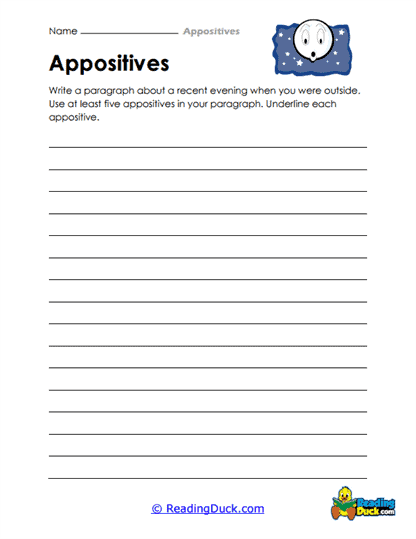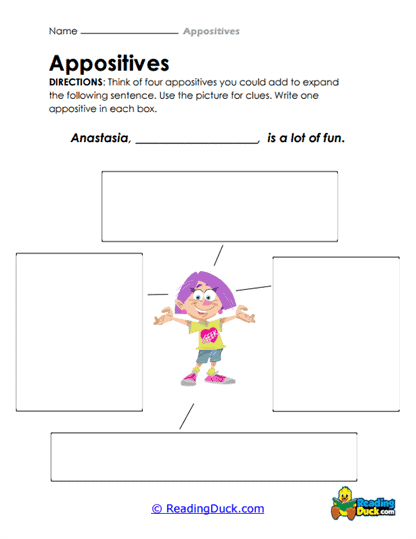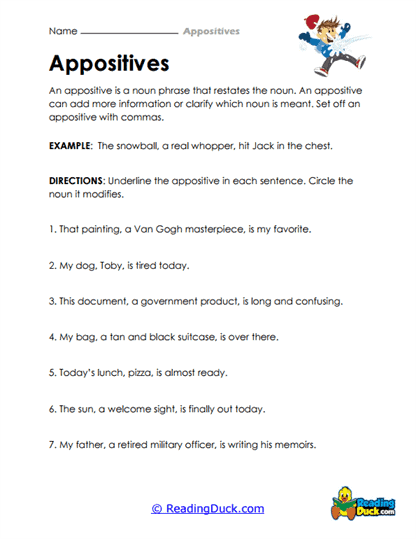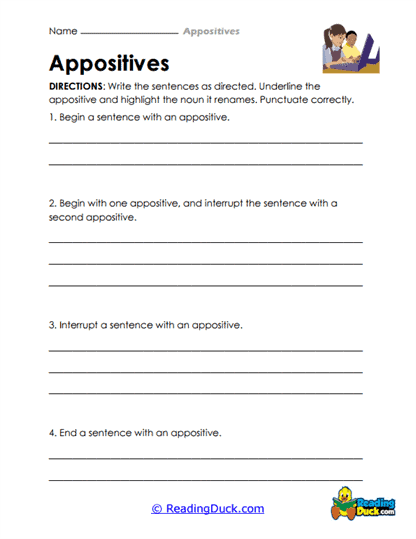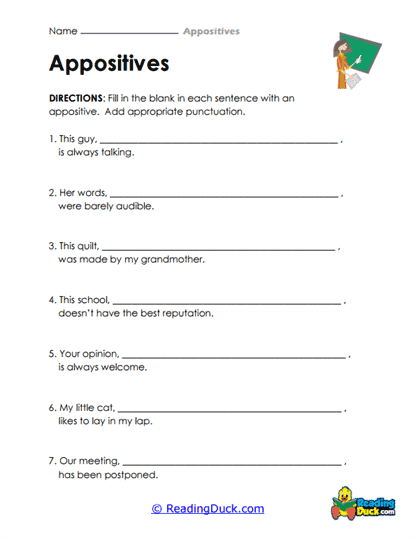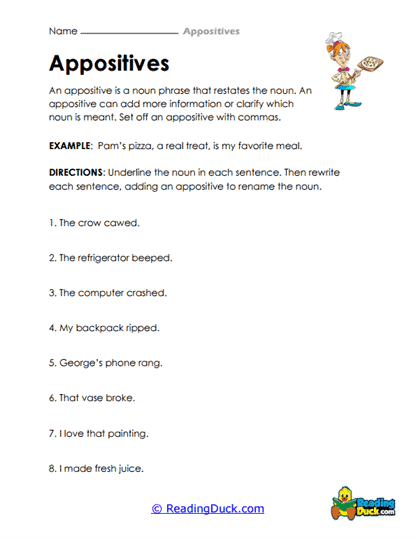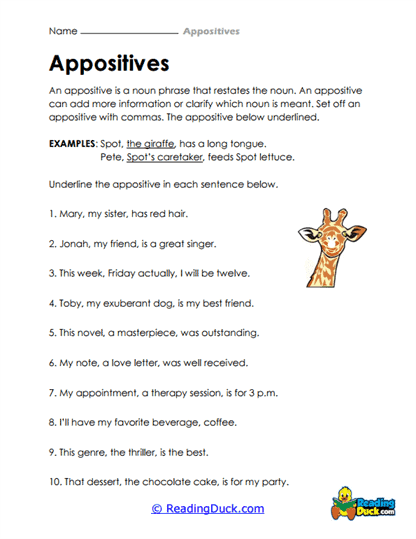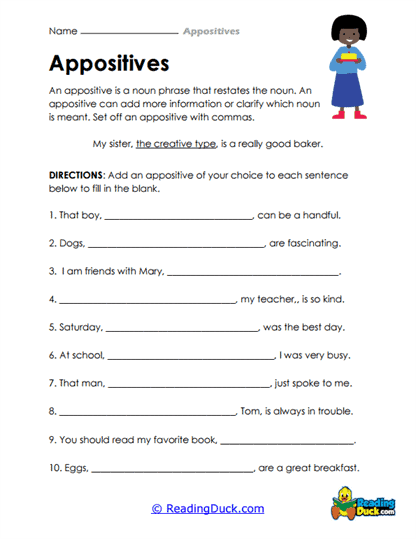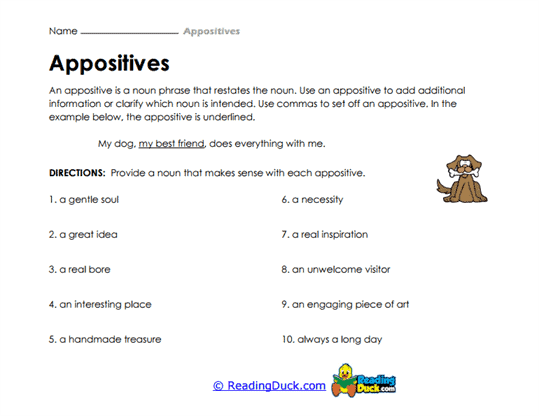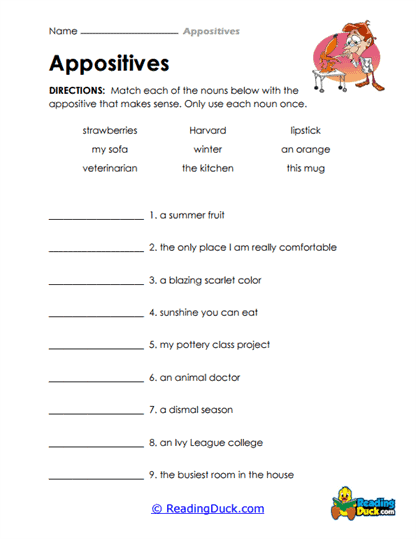Appositives Worksheets
About Our Appositives Worksheets
The Appositives Worksheets collection offers a focused approach to enhancing students' understanding of a key grammatical tool—appositives. Falling under the Grammar category within the Skills section, these worksheets are designed to guide students through the definition, identification, and correct usage of appositives in sentences. This collection strengthens students' ability to add clarity and detail to their writing, providing them with practical ways to improve sentence structure. By engaging with this collection, students will develop a solid grasp of how to use appositives to make their writing more sophisticated and precise.
The worksheets are presented in PDF format, which makes them easy to view, download, and print for use at home or in the classroom. Each worksheet comes with a downloadable answer key, enabling students and educators to check their work efficiently and reinforce correct grammar usage as they learn.
What Are Appositives? Understanding Their Role in Grammar
Appositives are an important grammatical structure that can enhance the clarity and depth of a sentence by providing additional information. When used correctly, they allow writers to combine details and ideas seamlessly, making sentences more informative and engaging. To fully understand appositives, it is important to break down their definition, functions, and various forms within sentences.
Definition of Appositives
An appositive is a noun or noun phrase that renames or provides further information about another noun or pronoun directly beside it in a sentence. Its purpose is to add extra information that identifies or clarifies the noun it follows, without needing to start a new sentence.
Example 1: "My brother, a talented musician, is performing tonight."
-
- Here, "a talented musician" is the appositive, providing more information about "my brother."
Example 2: "The city of Rome, Italy’s capital, is rich in history."
-
- In this example, "Italy’s capital" is the appositive, which renames or provides additional detail about "the city of Rome."
Types of Appositives
Appositives can take different forms depending on the level of detail they provide and how they are integrated into the sentence.
Restrictive (Essential) Appositives: These appositives are necessary for the meaning of the sentence. Without them, the sentence would be incomplete or unclear.
-
- Example: "My friend John is coming to the party." (Here, "John" is essential to specify which friend is being referred to.)
Nonrestrictive (Nonessential) Appositives: These appositives provide extra, but non-essential, information. They are usually set off by commas.
-
- Example: "My car, a red sedan, is parked outside." (The appositive "a red sedan" gives more information about the car, but it’s not necessary to understand the sentence.)
Positioning and Punctuation
Appositives are usually positioned directly after the noun they modify. Depending on whether the appositive is restrictive or nonrestrictive, punctuation (usually commas) plays a key role in setting off the appositive phrase.
Nonrestrictive appositives require commas to separate them from the rest of the sentence.
-
- Example: "My sister, an excellent cook, made dinner."
Restrictive appositives are not separated by commas because they are essential to the sentence’s meaning.
-
- Example: "The poet Emily Dickinson wrote many famous poems."
Understanding these distinctions helps students use appositives effectively to modify and expand their sentences, making their writing more detailed and nuanced.
Common Difficulties and Strategies for Learning Appositives
Learning to use appositives can present some challenges for students, especially when it comes to recognizing the difference between restrictive and nonrestrictive appositives and properly punctuating sentences. These challenges are common but can be addressed with clear explanations and practice.
Typical Challenges for Students
- Confusion with Punctuation: Students often struggle to determine when commas are necessary around appositives. Nonrestrictive appositives, which add extra information, require commas, while restrictive appositives do not. This distinction can confuse students as they first learn the concept.
- Identifying Appositives in Sentences: Some students may have difficulty recognizing appositives in complex sentences, particularly when they encounter long noun phrases or clauses that also provide descriptive information.
- Understanding the Role of Appositives: Another challenge lies in understanding when and why to use appositives. Students might fail to see how appositives can enhance their writing and might overlook opportunities to add them to their sentences for clarity and richness.
Strategies to Overcome These Challenges
Educators can use several strategies to help students master the use of appositives:
- Teach the Difference with Visual Aids: Use charts or visual organizers to demonstrate the difference between restrictive and nonrestrictive appositives. Showing examples of sentences with and without commas helps students understand when punctuation is needed.
- Appositive Identification Practice: Provide students with sample sentences and ask them to identify the appositive. Once they locate it, have them determine whether it’s restrictive or nonrestrictive, reinforcing the need for proper punctuation.
- Modeling and Sentence Construction: Educators can guide students through sentence construction by modeling how to add appositives. For example, present a simple sentence like "The teacher is grading papers," and ask students to add an appositive: "The teacher, an experienced educator, is grading papers."
- Daily Writing Prompts: Incorporating appositives into daily writing prompts allows students to practice using them in a natural context. This consistent practice can help students internalize the role of appositives in improving sentence structure.
Benefits of Learning Appositives for Communication Skills
Mastering the use of appositives contributes significantly to improving students’ reading, writing, and speaking abilities. Appositives help make communication clearer, more detailed, and more engaging by allowing students to seamlessly integrate additional information into their sentences.
Enhanced Reading Comprehension
When students understand how appositives function, they can better comprehend complex sentences in the texts they read. Appositives provide essential clarifications and additional details that can help students understand character descriptions, settings, and key concepts more deeply.
Improved Writing Skills
Using appositives enables students to write more fluidly and with greater detail. Instead of breaking information into multiple sentences, they can create more sophisticated sentence structures that integrate details smoothly. For example, instead of writing "Albert Einstein was a scientist. He developed the theory of relativity," students can write "Albert Einstein, a renowned scientist, developed the theory of relativity." This concise style improves the overall flow and depth of writing.
Clarity in Speech
In spoken language, the correct use of appositives allows speakers to convey additional information quickly and clearly. This skill is particularly useful in presentations and formal speaking engagements, where it’s important to provide details concisely without losing the audience’s attention.
Additional Activities to Reinforce Learning
Educators can use various engaging activities to reinforce the concepts taught in the Appositives Worksheets, both in school and homeschool settings. These activities encourage creativity and practical application, ensuring that students fully grasp the use of appositives.
Sentence Expansion Activity (Grades 4-8)
Students begin with simple sentences and expand them by adding appositives. For example, they start with "The dog barked," and expand it to "The dog, a playful golden retriever, barked loudly." This activity helps students see how appositives can add more depth and specificity to their sentences.
Appositive Scavenger Hunt (Grades 5-7)
In this activity, students search for appositives in books, articles, or stories they are reading. They underline the appositive and explain whether it is restrictive or nonrestrictive. This reinforces the skill of identifying appositives in context.
Collaborative Appositive Writing (Grades 6-8)
In groups, students create short paragraphs about a topic of their choice, incorporating at least three appositives. Each group then presents their work, explaining how they used appositives to add detail to their writing. This collaborative approach fosters critical thinking and teamwork.
Real-Life Importance of Appositive Mastery
Appositives are a valuable grammatical tool that students will use beyond the classroom. The ability to add descriptive information concisely and effectively is useful in various real-life scenarios, such as writing reports, essays, and professional correspondence. In everyday conversation, appositives enable individuals to clarify meaning and convey complex ideas more clearly.
Whether students are writing academic papers, drafting resumes, or engaging in professional communication, mastering appositives enhances their ability to convey information efficiently and effectively. The Appositives Worksheets collection offers a practical, structured approach to mastering this important skill, ensuring that students develop the grammatical foundation they need for success in both academic and real-world settings.
